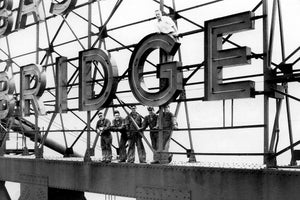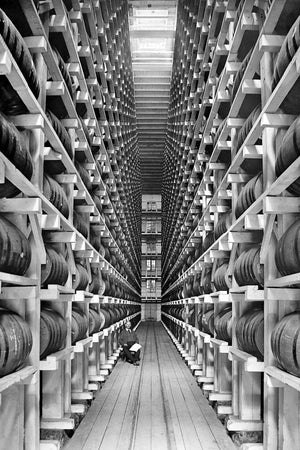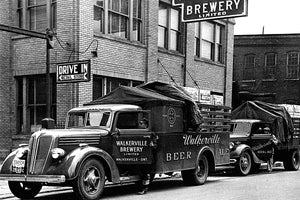Little do the patrons of a local nightclub realize they are dancing in a building that was once the site of a real-life cops-and- robbers drama.
June 9, 1959 was an unforgettable day to anyone in or near the Bank of Montreal at
Chilver and Wyandotte in Olde Walkerville. Two men, Nicholas Hamilton (alias
McCormick) of Vancouver and Kenneth Irwin of Toronto, wearing white jackets,
hoods, and sunglasses, entered the bank that afternoon, armed and ready to get
their black-gloved hands on some easy cash.
Adele Pare, a local housewife, was making a withdrawal when one of the men thrust
a gun into her back and grabbed her, exclaiming, “This is a stickup. Do as we say or
you’ll get it, and we mean it.” The men forced her and another customer into a
corner of the vault along with the bank’s 15 employees. The chief clerk, Norman
Wingrover, tripped the alarm along the way. The three female tellers were robbed of
a total of $10,733 before the pair attempted to make their getaway.
The first officer to arrive at the scene was Const. Brian Pickup. He had spent eight
years as a policeman in his native England before moving to Windsor and joining the
force in 1957. Forty years later, Pickup can still recall the incident quite clearly. “A
call came out over the radio saying there was a robbery at the bank. When I got
there a large group of people had gathered around the building.”

"I saw a woman with her hands in the air, and then a man with a bag in one hand and a gun in the other"
He had only seconds to take in the scene. “As I got to that block, I saw a woman with
her hands in the air, and then a man with a bag in one hand and a gun in the other. I
didn’t draw my gun because a stray bullet could have gone into the crowd.”
Instead, Pickup lunged for the robber, Nicholas Hamilton, throwing him over his
shoulder onto the sidewalk and kneeling on him to hold him down until the other
officers arrived. Unfortunately, he was unable to see inside the bank, and assumed
that the man he was holding captive had been working alone.
That mistake could have cost him his life.
“The second man came out and I heard a shot.” Pickup was hit!
The bullet slammed into his back, exited his stomach and went into his knee, but still
he held onto his catch. As he speaks, Pickup emphasizes the names of the officers
who came to his assistance and arrested the shooter, Kenneth Irwin.
“Constables Washbrook and Rowley saw that the man was going to shoot me again,
and shot at him.” A gun fight ensued. Washbrook and Rowley fired from behind one
end of a station wagon as their assailant returned their shots from the other.
Approximately six shots were fired (one of them smashing a car’s tail light) before
Irwin finally gave up, lowering his weapon. Pickup held onto Hamilton while they
arrested him as well.

After the incident, an inspection of the getaway car resulted in the discovery of a
suitcase in the back seat containing another gun. The car had been stolen in
Kingston a week earlier, just after the thieves had been released from Kingston
Penitentiary.
Brian Pickup was taken to Metropolitan hospital to endure a four-hour operation.
His wife, Vera, kept a vigil at the hospital as he fought for his life. “He wasn’t
supposed to live through the night,” she told reporters a few days after the
incident.He did make it through the night, however, and made a full recovery after
seven weeks in the hospital and another six at home. He recalls his recovery time
clearly as well.
“It wasn’t incredibly difficult, since my weight went down from 180
pounds to 118. It was quite a while before I could walk and drive again.”
The only repercussion from his injuries is a bit of stiffness in his one knee. All in all, he says, “I think I came out pretty good.”
Nicholas Hamilton (charged under the name McCormick) was sentenced to 15 years
in the Kingston Penitentiary. Kenneth Irwin, the shooter, was sentenced to 25. He
died of natural causes in prison five years later.

After about a year had passed and a full recovery was made, Pickup received a piece
of mail from Ottawa, marked “Confidential.” He didn’t notice the three letters that
followed his name until he opened the envelope. “I have the pleasure of informing
you that Her Majesty the Queen has been graciously pleased to approve my
recommendation of the award to you of the British Empire Medal for Gallantry in
recognition of your bravery. In accordance with Section XXXVI of the Royal Warrant
instituting the British Empire Medal, you are now entitled to have placed after your
name the letters B.E.M.”
The letter was signed by Canada’s Secretary of State, Leon Balcer. It was the first
British Empire Medal ever awarded to a Canadian police officer.
“I was surprised,” Pickup states simply. “All I knew was that I had been
recommended for a police medal.”
Did the award affect the way he was treated by his co-workers? “Not really, but I did
get a lot of support from the other officers.”
The incident, he says, didn’t really change the way he looked at his profession from
then on. “It was a part of my job that I had to do, and I kept on doing it afterwards.”
Pickup remained on the force until 1988, when he retired and became a travel agent,
a job he’s still enjoying today. Two of his daughters work in central records for the
Windsor Police.
Pickup held onto the bullet that had travelled through his body until just two
months before this article was written.
Special thanks to Joan Urie, one of the tellers involved in the robbery, who provided
us with news clippings about that fateful day. She recalls a big gun in her face and
the words “Move or I’ll shoot!” She, along with 14 other bank employees and two
customers were herded into the vault until help arrived.
By Chris Edwards, Walkerville Publishing








